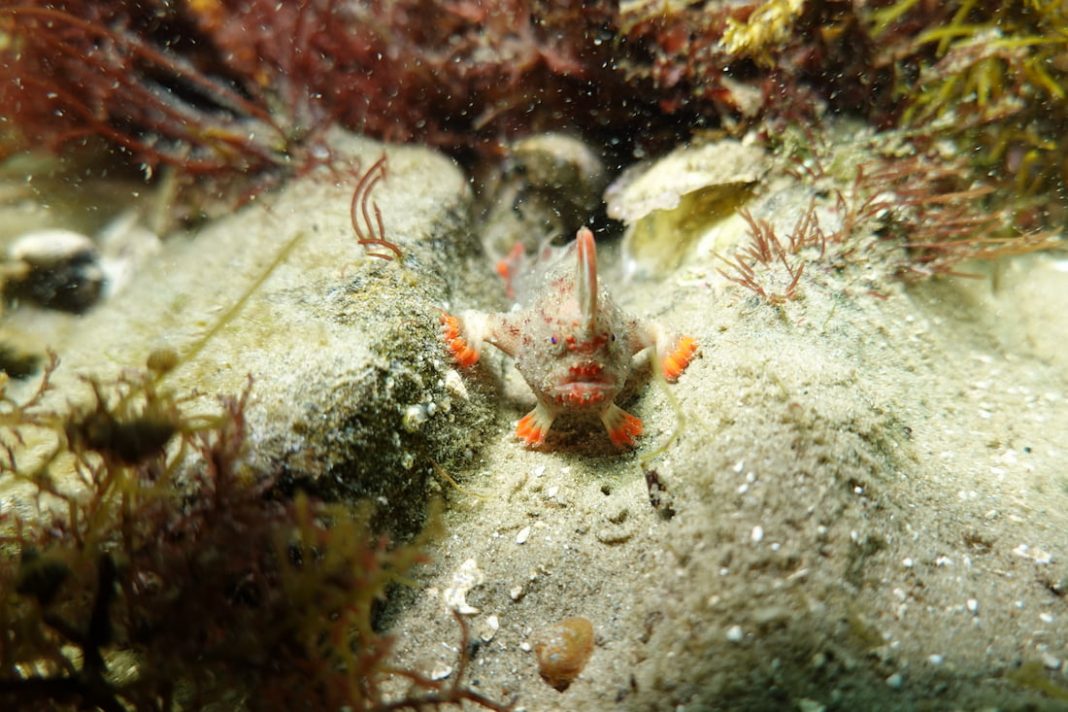On two tiny patches of reef in Tasmania a bizarre walking fish with over-sized jazz hands and a fluffy pom-pom on its head is barely hanging on.
With just 100 or so left in the wild, the aptly named red handfish makes Australia’s other critically endangered species seem positively abundant.
But a team of dedicated researchers has been toiling for years to ensure the survival of the grumpy-looking creature, about which little is known.
Threatened species ecologist Tyson Bessell says it’s a complicated business attempting to unravel the secrets of an animal while simultaneously trying to save it from extinction.
But the work he has done for his PhD, including efforts to establish a baseline estimate of how many are left, is helping plug some of the gaps.
His conclusions are sobering. It’s estimated there are roughly 10 red handfish at one of the sites and 90 at the other.
“The site that has 10 fish left … back in the ’90s was quoted to have hundreds of red handfish to the point you had to be careful where you stepped in the shallows,” he says.
“Now, you have to search for hours and be very, very good at finding them to find one, with only 10 in the space of probably a soccer field. In the absence of a dedicated long term study tracking their decline, that’s what resonated with me.”
The red handfish is one of the three critically endangered handfish at the centre of a national conservation project established in 2018.
The other two are the spotted handfish, thought to now number fewer than 3000, and Ziebell’s handfish, last seen in 2007.
Mr Bessell says there are many reasons the three species – and handfish worldwide – are in trouble.
In the case of the red handfish, primary threats include climate change, pollution and overgrazing of its habitat by the short-spined sea urchin, which has flourished thanks to the decline of its predator, the lobster.
The red handfish also has some intrinsic challenges that prevent it making new homes in new places.
It can swim but lacks a swim bladder to aid the process and prefers to use its hand-shaped pectoral fins to “walk” across the seafloor.
As one might imagine, it can be slow going and Mr Bessell’s research has shown they really don’t move very much, making the species extremely susceptible to any changes in the small areas they inhabit.
“The furthest a fish has moved within my study was 100 metres but that was in 540 days,” he says. “The smallest distance … was 30cm in 500 days.”
To make matters worse, red handfish don’t spend their early stages drifting as larvae within the water column, like other species. Essentially, they stay where they hatch.
So everything considered, what’s the best way to ensure the visually spectacular and charismatic species doesn’t vanish from the face of the planet?
Currently the focus is on a helping human hand, something Mr Bessell sees as a moral obligation given human pressures have landed it in hot water.
For some time, researchers have been carefully harvesting clutches of wild red handfish eggs and rearing them in captivity before returning them to their homes in Frederick Henry Bay.
It’s hoped that will greatly increase the numbers that will survive long enough to reproduce.
Mr Bessell recalls a nerve wracking mission, a few years ago, to release carefully reared handfish into the wild.
“The feeling of like, ‘wow this is actually conservation action’. I felt privileged to be a part of that.
“There were three groups of us and each had five or so fish to release.”
It was a meticulously planned mission to get the fish from where they’d been reared, onto a boat, out into the bay and then down to the seafloor for release by the scuba teams.
“I remember tipping the bag up and thinking, ‘out you go, welcome to the real world’.
“Four of them swam out really quite peacefully but there was a fifth that didn’t … It was like a kid that didn’t quite want to leave but it did eventually.
“We sat there, watching these fish, for 10 minutes or so just to make sure they were ok. It was just really nice to see that.”
The feeling of privileged awe the researcher describes is familiar to biologist Rachelle Hawkins, who has been breeding seahorses for research, public and private aquaria for the past 25 years.
The owner of Seahorse World, north of Launceston, has helped rear red handfish in captivity and treasures a sense of achievement at handing 18 of them back to researchers for release a few years ago.
She and the Sea Life Melbourne Aquarium recently received some new wild spotted handfish and will both attempt to breed them in coming months.
She’s hoping for success, having also done this in 2017.
Back then there was no way to tell the sexes of the fish they had, so it was a case of hope, wait and see.
“For years we were guessing what sexes we had in the tanks. But then the Melbourne aquarium employed the use of ultrasound technology.
“If you get them at the right time you are able to see the eggs or sperm in there, through ultrasound. That was quite revolutionary, so then we could sex them and make sure we had a male and a female.
“Now that technology is available, and we have another 10 and Melbourne has got another 10, we’re going to try again, starting from a better knowledge point.
“Hopefully we’ll have some spotted handfish to release in the not too distant future.”
The national handfish recovery team is co-ordinating research for the three handfish species in line with their recovery plans.
It includes experts from government, the CSIRO and Institute for Marine and Antarctic Studies at the University of Tasmania.



